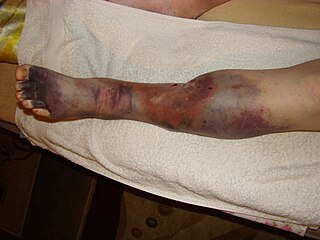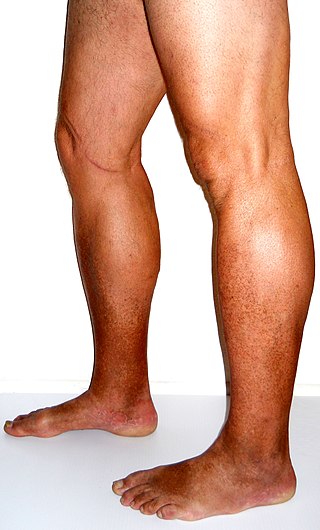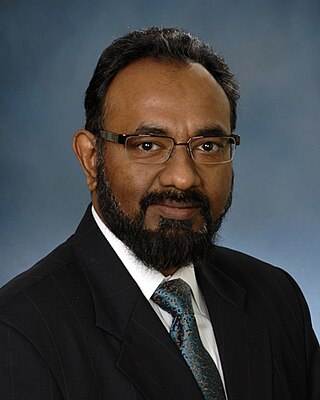Related Research Articles

Lymphedema, also known as lymphoedema and lymphatic edema, is a condition of localized swelling caused by a compromised lymphatic system. The lymphatic system functions as a critical portion of the body's immune system and returns interstitial fluid to the bloodstream.

Varicose veins, also known as varicoses, are a medical condition in which superficial veins become enlarged and twisted. These veins typically develop in the legs, just under the skin. Varicose veins usually cause few symptoms. However, some individuals may experience fatigue or pain in the area. Complications can include bleeding or superficial thrombophlebitis. Varices in the scrotum are known as a varicocele, while those around the anus are known as hemorrhoids. Due to the various physical, social, and psychological effects of varicose veins, they can negatively affect one's quality of life.

Vascular surgery is a surgical subspecialty in which vascular diseases involving the arteries, veins, or lymphatic vessels, are managed by medical therapy, minimally-invasive catheter procedures and surgical reconstruction. The specialty evolved from general and cardiovascular surgery where it refined the management of just the vessels, no longer treating the heart or other organs. Modern vascular surgery includes open surgery techniques, endovascular techniques and medical management of vascular diseases - unlike the parent specialities. The vascular surgeon is trained in the diagnosis and management of diseases affecting all parts of the vascular system excluding the coronaries and intracranial vasculature. Vascular surgeons also are called to assist other physicians to carry out surgery near vessels, or to salvage vascular injuries that include hemorrhage control, dissection, occlusion or simply for safe exposure of vascular structures.

Telangiectasias, from Greek: tel- (end) + angi- + ectasia, also known as spider veins, are small dilated blood vessels that can occur near the surface of the skin or mucous membranes, measuring between 0.5 and 1 millimeter in diameter. These dilated blood vessels can develop anywhere on the body, but are commonly seen on the face around the nose, cheeks and chin. Dilated blood vessels can also develop on the legs, although when they occur on the legs, they often have underlying venous reflux or "hidden varicose veins". When found on the legs, they are found specifically on the upper thigh, below the knee joint and around the ankles.

Sclerotherapy is a procedure used to treat blood vessel malformations and also malformations of the lymphatic system. A medicine is injected into the vessels, which makes them shrink. It is used for children and young adults with vascular or lymphatic malformations. In adults, sclerotherapy is often used to treat spider veins, smaller varicose veins, hemorrhoids, and hydroceles.

The deep femoral vein, deep vein of the thigh or profunda femoris vein, is a large deep vein in the thigh. It collects blood from the inner thigh, passing superiorly and medially alongside the deep femoral artery before emptying into the femoral vein.

Venous ulcer is defined by the American Venous Forum as "a full-thickness defect of skin, most frequently in the ankle region, that fails to heal spontaneously and is sustained by chronic venous disease, based on venous duplex ultrasound testing." Venous ulcers are wounds that are thought to occur due to improper functioning of venous valves, usually of the legs. They are an important cause of chronic wounds, affecting 1% of the population. Venous ulcers develop mostly along the medial distal leg, and can be painful with negative effects on quality of life.

Diosmin, a flavone glycoside of diosmetin, is manufactured from citrus fruit peels as a phlebotonic non-prescription dietary supplement used to aid treatment of hemorrhoids or chronic venous diseases, mainly of the legs.

Vascular disease is a class of diseases of the vessels of the circulatory system in the body, including blood vessels – the arteries and veins, and the lymphatic vessels. Vascular disease is a subgroup of cardiovascular disease. Disorders in this vast network of blood and lymph vessels can cause a range of health problems that can sometimes become severe, and fatal. Coronary heart disease for example, is the leading cause of death for men and women in the United States.

Post-thrombotic syndrome (PTS), also called postphlebitic syndrome and venous stress disorder is a medical condition that may occur as a long-term complication of deep vein thrombosis (DVT).
The term venous translucence has been used in phlebology since 1996 by surgeon Pedro Fernandes Neto during ambulatory clinical exams in Brazil. His results were published in the annals of the national and international congresses of angiology. Venous translucence is the process of reflective image visualization of veins by light, which reaches up to the superficial venous system. It is a non-invasive method. Since it is a simple, low-cost technique it can be repeated as needed, which is useful in disease-process monitoring. It is a new diagnostic procedure, still undergoing investigation; more analysis is necessary to hone its technical aspects. Venous translucence is based on optical physics. It is caused by the refraction, absorption and reflection of light. The color which is not absorbed is reflected, and is the one that is seen. Therefore, venous translumination is based on the incidence of luminosity on the vein, where part of the light is absorbed and another reflected.

Chronic venous insufficiency (CVI) is a medical condition in which blood pools in the veins, straining the walls of the vein. The most common cause of CVI is superficial venous reflux which is a treatable condition. As functional venous valves are required to provide for efficient blood return from the lower extremities, this condition typically affects the legs. If the impaired vein function causes significant symptoms, such as swelling and ulcer formation, it is referred to as chronic venous disease. It is sometimes called chronic peripheral venous insufficiency and should not be confused with post-thrombotic syndrome in which the deep veins have been damaged by previous deep vein thrombosis.

Peter Lin is an American vascular surgeon, medical researcher, specializing in minimally invasive endovascular treatment of vascular disease. He has published extensively in the area of vascular surgery and endovascular surgery.
Phlebology is a medical speciality that is concerned with venous issues including the diagnosis and treatment of disorders of the veins. A medical specialist in this field is known as a phlebologist. The specialty of phlebology has developed to enable physicians sharing an interest in venous disease and health to share knowledge and experience despite being trained in a variety of backgrounds such as dermatology, vascular surgery, haematology, interventional radiology or general medicine. Diagnostic techniques used include the patient's history and physical examination, venous imaging techniques in particular vascular ultrasound and laboratory evaluation related to venous thromboembolism. The American Medical Association and the American Osteopathic Association have added phlebology to their list of self-designated practice specialties.

Veinoplus is a class IIa medical device with CE marking. It is indicated for the treatment of vascular diseases. This is a neuromuscular stimulator developed by an American scientist, Jozef Cywinski.

Perforator veins are so called because they perforate the deep fascia of muscles, to connect the superficial veins to the deep veins where they drain.
The Society for Vascular Surgery (SVS) is the major national academic society for vascular surgery in the United States. Its mission includes education, research, career development and advocacy. The SVS is the national advocate for more than 6,000 specialty-trained vascular surgeons and other medical professionals who are dedicated to the prevention and cure of vascular disease. The association was founded in 1946. The SVS is the sponsor organization for the Journal of Vascular Surgery (JVS) and for the national Vascular Annual Meeting (VAM).
Fibro-adipose vascular anomaly, also known as FAVA, is a type of vascular anomaly that is both rare and painful. FAVA is characterized by tough fibrofatty tissue taking over portions of muscle, most often contained within a single limb. FAVA also causes venous and/or lymphatic abnormalities.
Kenneth Arthur Myers FRACS FACS was an Australian surgeon specialising in phlebology.

Brajesh K. Lal, born in 1963 in Varanasi, India and of Indian origin, is an American surgeon, and an expert in vascular disease, particularly the prevention and treatment of stroke and venous disease.
References
- ↑ "American Venous Forum fosters research & clinical innovation – Promoting venous and lymphatic health". www.veinforum.org. Retrieved 2021-03-04.
- ↑ "Venous Education Series". www.veinforum.org. Retrieved 2021-03-27.
- ↑ Siddiqi, Hasan K.; Libby, Peter; Ridker, Paul M (January 2021). "COVID-19 – A vascular disease". Trends in Cardiovascular Medicine. 31 (1): 1–5. doi:10.1016/j.tcm.2020.10.005. ISSN 1050-1738. PMC 7556303 . PMID 33068723.
- ↑ "COVID-19". www.veinforum.org. Retrieved 2021-03-27.
- ↑ Lurie, Fedor; Lal, Brajesh K.; Antignani, Pier Luigi; Blebea, John; Bush, Ruth; Caprini, Joseph; Davies, Alun; Forrestal, Mark; Jacobowitz, Glenn; Kalodiki, Evi; Killewich, Lois (2019-01-01). "Compression therapy after invasive treatment of superficial veins of the lower extremities: Clinical practice guidelines of the American Venous Forum, Society for Vascular Surgery, American College of Phlebology, Society for Vascular Medicine, and International Union of Phlebology". Journal of Vascular Surgery: Venous and Lymphatic Disorders. 7 (1): 17–28. doi:10.1016/j.jvsv.2018.10.002. ISSN 2213-333X. PMID 30554745. S2CID 58768019.
- ↑ Lurie, Fedor; Lal, Brajesh K.; Antignani, Pier Luigi; Blebea, John; Bush, Ruth; Caprini, Joseph; Davies, Alun; Forrestal, Mark; Jacobowitz, Glenn; Kalodiki, Evi; Killewich, Lois (2019-01-01). "Compression therapy after invasive treatment of superficial veins of the lower extremities: Clinical practice guidelines of the American Venous Forum, Society for Vascular Surgery, American College of Phlebology, Society for Vascular Medicine, and International Union of Phlebology". Journal of Vascular Surgery: Venous and Lymphatic Disorders. 7 (1): 17–28. doi:10.1016/j.jvsv.2018.10.002. ISSN 2213-333X. PMID 30554745. S2CID 58768019.
- ↑ Masuda, Elna; Ozsvath, Kathleen; Vossler, John; Woo, Karen; Kistner, Robert; Lurie, Fedor; Monahan, Dan; Brown, William; Labropoulos, Nicos; Dalsing, Michael; Khilnani, Neil (2020-07-01). "The 2020 appropriate use criteria for chronic lower extremity venous disease of the American Venous Forum, the Society for Vascular Surgery, the American Vein and Lymphatic Society, and the Society of Interventional Radiology". Journal of Vascular Surgery: Venous and Lymphatic Disorders. 8 (4): 505–525.e4. doi: 10.1016/j.jvsv.2020.02.001 . ISSN 2213-333X. PMID 32139328.
- ↑ O’Donnell, Thomas F.; Passman, Marc A.; Marston, William A.; Ennis, William J.; Dalsing, Michael; Kistner, Robert L.; Lurie, Fedor; Henke, Peter K.; Gloviczki, Monika L.; Eklöf, Bo G.; Stoughton, Julianne (2014-08-01). "Management of venous leg ulcers: Clinical practice guidelines of the Society for Vascular Surgery® and the American Venous Forum". Journal of Vascular Surgery. 60 (2): 3S–59S. doi: 10.1016/j.jvs.2014.04.049 . ISSN 0741-5214. PMID 24974070.
- ↑ "Vein Handbook | The Layman's Handbook of Venous Disorders". www.veinforum.org. Retrieved 2021-03-27.
- ↑ "American Venous Forum News and Publications". www.veinforum.org. Retrieved 2021-03-27.
- ↑ "Index of Articles of Excellence".
- ↑ "Home Page: Journal of Vascular Surgery: Venous and Lymphatic Disorders". www.jvsvenous.org. Retrieved 2021-03-04.
- ↑ https://www.jvsvenous.org/.
{{cite book}}: Missing or empty|title=(help)